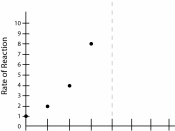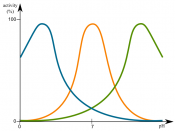This experiment aims to find the factors that effect enzymes focusing on concentration for the test itself. This test will involve the enzyme amylase and starch to test the effect of concentration on a substrate.
The enzyme amylase has a certain protein structure meaning it can only link with starch much like puzzle boards only have certain peices that fit into each other. It is this shape that the enzyme has that causes the reaction (a puzzle could not be completed if the peices didn't fit into each other) This process is known as hydrolysis and usually occurs in the presence of water, under highly acidic conditions however (amylase being highly acidic) it can break down biological substances into fatty acids and in this case maltose.
The factors that effect enzymes are- *temperature: Increasing the temperature leads to an increase of particle movement and increases the chance of the enzyme hitting a starch particle.
When they do collide they link together and react so an increase in temperature causes a higher rate of enzyme reaction. Above about 60? enzymes begin to collapse causing them to be unreactive, it is said they are denatured.
*PH: All enzymes must have the right conditions to work as, if the PH is either too acidic or too alkali then they become denatured and can no longer link with other chemicals. That is the reason why enzymes such as pepsin can only reside in the stomach as they can only work in acidic conditions (PH 1-3).
concentration: This is the factor i will be concentrating on in this experiment. If there are more amalase particles during the reaction the substrate will have an abundance of molecules to link with and a higher chance of collision thus allowing the reaction to be completed.


